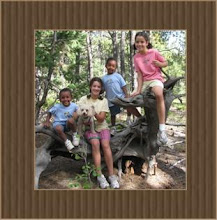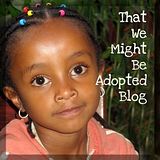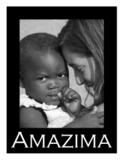Letter example #1
"What to expect when we are home from Ethiopia"
Dear ___________
Adopting a preschool-age child is very different from bringing a newborn home from the hospital, but there are some similarities: You want everyone to come to the (hospital) airport to see your new child. That is the same. You want the house quiet, calm, low stimulus. That is the same. You want to limit visitors for the first several weeks. That is the same.
The similarities end there. _____ will hardly know her new mommy and daddy. We will be taking her on a long flight and leaving behind her loving nannies and friends. She will no longer be sharing a bunk with her friend in a room full of girls, but a room with her sister. She has never seen snow or felt the cold __________air. The language, the smells, the customs and routines will all be new. She needs time to get to know us and trust us. She needs to know that family members are safe to love and love deeply.
_______ is __years old. We do know pieces of what her life has been like until now and the circumstances surrounding her adoption. Though it is a encouraging testimony of God's grace, we are choosing to save the details of her story for her to share, when she chooses.
After consulting with other adoptive families from our community and other areas, and at the advice of adoption professionals, this is our plan: Once we arrive home we will have a no-visitors policy for 1 month. This is our time as a family to adjust to new family dynamics. High nurture and high structure are our goals. After this time, we will begin branching out a bit, but will still minimize our outside contacts until we see that she is feeling more secure in this new context.
Thank you in advance for your understanding and respect of how important these next few months are for our family. We want to start off doing what is best for __________ though parts may be difficult for the rest of us. We look forward to continuing to share life with all of you, with our whole family!!!
With much love and anticipation,
____________
Letter example #2
We wrote his up in preparation for ___ arrival and are sharing it with friends & family. I thought I'd post it here, too, to better explain the importance of attachment and to help others who might be adopting or who know other adoptive families...
Dear Family & Friends,
After over two years of waiting, our precious ___ is finally home! We know that each of you receiving this letter has, in some way, supported, loved and prayed for us. Because we know your care for ___ and our family, we want to share with you some information that we hope will best equip everyone around him to assist us in laying the strongest and healthiest foundation - emotionally, physically and spiritually.
In many ways, ___ will be like the children who entered our family through birth; we will parent like other Christian families as we bring all of them up in the instruction and discipline of the Lord. But there will be a few, initial differences. For years now, we have researched bonding and attachment in children, especially those coming home through adoption from an institutional orphanage setting.
We are confident of this: God's design is PERFECT! His plan for parents and children is a beautiful and meaningful picture of His love for us. Attachment between a parent and child occurs over time when a baby has a physical or emotional need and communicates that need. The primary caretaker (usually mommy) meets the need and soothes the child. This repeats between a parent and child over and over to create trust within the child for that parent; the baby is hungry, cries in distress, mom nurses & calms the baby - which teaches him that this person is safe and can be trusted. By God's very design, an emotional foundation is laid in the tiniest of babies, which will affect their learning, conscience, growth and future relationships. The security provided by parents will, ultimately, give children a trust for and empathy towards others.
Children who come home through adoption have experienced interruptions in this typical attachment process. The loss of a biological mother at an early age can be a major trauma on their little hearts. The good news is that we can now, as ___'s parents and forever family, rebuild attachment and help him heal from these emotional wounds. When ___ comes home, he will be overwhelmed. Everything around him will be new and he will need to learn not just about his new environment, but also about love and family. He has not experienced God's design for a family in an orphanage setting. The best way for us to form a parent/child bond is to be the ones to hold, snuggle, instruct, soothe and feed him. As this repeats between us, he will be able to learn that parents are safe to trust and to love deeply. We are, essentially, recreating the newborn/parent connection. Once __ starts to establish this important bond, he will then be able to branch out to other, healthy relationships.
___ will have, what may seem like, a lot of structure, boundaries and close proximity to us. Please know that these decisions are prayerfully and thoughtfully made choices based on immense amounts of research and instruction from trusted adoption mentors. We will be doing what we believe is best to help him heal from those interruptions in attachment as effectively as possible. Why are we telling you all of this? Because you will actually play an awesome and vital role in helping our ___ settle in, heal, and lay a foundation for the future. There are a few areas in which you can help us:
The first is to set physical boundaries. It will help us immensely if adults limit what is typically considered normal, physical contact with __. This will (for a while) include things like holding, excessive hugging and kissing. Children from orphanage settings are prone to attach too easily to anyone and everyone - which hinders the important, primary relationship with parents. Waving, blowing kisses or high fives are perfectly appropriate and welcomed! __ should know that the people with whom he interacts are our trusted friends.
Another area is redirecting __'s desire to have his physical and emotional needs met by anyone (including strangers) to having us meet them. Orphans often have so many caretakers that they, as a survival mechanism, become overly charming toward all adults. A child struggling to learn to attach may exhibit indiscriminate affection with people outside of their family unit. It may appear harmless and as if they are "very friendly" but this is actually quite dangerous for the child. To share this is difficult for us because we have snuggled, cared for, fed and loved so many of your children. Please understand that we want nothing more than to have __ hugged, cuddled and cherished by ALL of you (he's totally irresistible and huggable). But until he has a firm understanding of family and primary attachments, we would be so grateful if you direct him to us if you see that he is seeking out food, affection or comfort.
We are incredibly blessed to have so many loved ones around us. We couldn't ask for a better extended family & circle of friends for our precious __. Thank you so much for your love and support over the past two years. If you have any questions please feel free to ask at any time!
Example Letter #3
Dear Friends and Family:
Very soon, we’ll be bringing ----------- home and starting the process of becoming a new and bigger family. This is an exciting and scary time for all of us, especially for -------------. In his short life, our son has gone through more changes and life altering experiences than most adults could handle. He's already experienced the loss of a birthmother (replace with your child’s situation) and will soon experience the loss of familiar and comforting caretakers as well as the sights, smells, and language of his birth country. His world will turn upside down. He will be disoriented and confused. He will struggle with feeling safe and secure and lack the ability to trust that we will meet his needs.
The process of learning to trust that we are the two adults in his world who will always be there to care for him is called attachment. You know that building trust is hard, takes a lot of time and a lot of work. It gets easier over time, but things are going to be a little strange at first and we ask that you please understand and respect what’s happening. We are not closing you out, you are the most important people in our lives. But ---------- needs to have boundaries in place to develop a strong, and healthy attachment to us.
Physical Boundaries
It will help us immensely if adults limit what is typically considered normal, physical contact with -------------. This will (for a while) include things like holding, excessive hugging and kissing. Children from orphanages are prone to attach too easily to anyone and everyone. Unfortunately, this disrupts his ability to attach to us. Waving, blowing kisses or high fives are perfectly appropriate and welcomed! ----------------- should know that you are our trusted friends and family.
Caretaking
------------ has gone from having a caring mother to relying on a stream of different adults to meet his needs. He’s learned that he has to compete for the attention of every adult he sees to get basic things like food, clothing, blankets and comfort. Charming every available adult becomes a survival technique. While that might work in an orphanage, it’s dangerous in our world. It’s not safe for ------------- to ask random strangers for a hug. In order for ----------- to learn healthy, appropriate boundaries with strangers, he has to begin by learning that we are the two people responsible for meeting his needs. For a while, we need to be the only ones to hand him food, give him water, comfort him when he bumps his head. If he asks you for something, please ask us. For a while, it will look like we’re spoiling him. As he learns that we are his parents, it will become OK to treat Fisher just like our other ones.
Discipline
Because of his experiences, ------------- might have learned that adults are scary and unreliable. A gentle scolding can feel like a ton of bricks to him. Discipline will be very tricky. Just as it is important for ------------ to understand who his caretakers are, he needs to learn that we (and not every adult he sees) are ------------ authority figures to be trusted not to hurt him and yet still hold him to a standard.
Thank You
Thank you for understanding and supporting us in this amazing, but challenging time! We’re sure you can’t wait to read more, so here are some links below on attachment in international adoption.
Your names
p.s. - Some Resources
An article on attachment in school-age children. (http://www.pactadopt.org/press/articles/attach-school.html)
A pamphlet courtesy of the Feds. Attachment is discussed on page 4. (http://www.childwelfare.gov/pubs/factsheets/parent_school_age/parent_school_age.pdf)
A brief article on attachment. (http://www.earlyinterventionsupport.com/parentingtips/adoption/healthyattachments.aspx)
A scholarly article. (There are probably better ones, but we don’t have good access to those). (http://www.ahealthymind.org/ans/library/Adoption%20Gribble%2007.pdf)
An article on attachment from Focus on the Family (focusing on the secular aspects at the beginning) (http://www.focusonthefamily.com/parenting/adoptive_families/attachment_and_bonding/promoting_healthy_attachment.aspx)
A blog post on how it might feel to be a child in an international adoption. (http://benjaminandholly.blogspot.com/2009/04/attachment-analogy.html)
A blog post on how undeveloped attachment looks in the real world. (http://adoption.families.com/blog/trust-and-attachment)
A web article on adopting school-age kids. (http://www.suite101.com/content/attaching-to-adopted-school-age-kids-a60661)
A short blurb on adopting older kids by noted author Karen Purvis. (http://www.adoptivefamilies.com/articles.php?aid=1090)











































No comments:
Post a Comment
Please leave a comment: